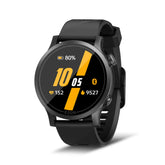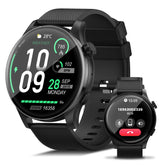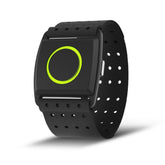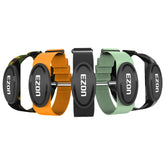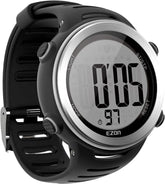Biking for Fitness: Heart Rate Monitors and Digital Maps for Great Rides
Cycling is more than a sport—it’s a journey of fitness and exploration. With heart rate monitors for intensity control and digital sports watches for biking routes, you’ll transform rides into strategic workouts and adventures. This guide shows how to balance effort and discovery, using data to boost fitness and map your way to better rides.
1. Master Intensity with Heart Rate Zones
A. 5 Heart Rate Zones for Cyclists
- Zone 2 (60–70% Max HR): 60% of rides for endurance (e.g., 2-hour steady rides to build aerobic base).
- Zone 3 (70–80% Max HR): 30% of rides for tempo efforts (提高乳酸阈值,e.g., 4x15-minute climbs at FTP).
- Zone 4 (80–90% Max HR): 10% of rides for high-intensity intervals (e.g., 8x1-minute sprints) to boost speed.
- Heart Rate Monitor Tip: Use real-time alerts to stay in target zones—overstepping into higher zones too early leads to burnout.
B. FTP (Functional Threshold Power) Basics
- How to Calculate: 20-minute all-out effort; FTP = 95% of average power (or heart rate) from that effort.
- Training Impact: Zone 3 rides at 88–94% FTP improve sustainable race pace, guided by your monitor’s real-time data.
2. Explore with Digital Maps: Turn Rides into Adventures
A. Route Planning Features
- GPS Navigation: Preload routes from Komoot or Strava into your digital sports watch, complete with turn-by-turn alerts to avoid getting lost.
- Terrain Filter: Search for routes with 30% climbs and 70% flats to balance strength and speed training.
B. Real-Time Data Overlays
- Elevation Alerts: Get notified of steep climbs (e.g., “15% grade ahead—shift to easy gear”) to conserve energy.
- Pace Guidance: Set target speed for flat sections (e.g., 25 km/h) and let your watch vibrate if you’re off track.
3. 8-Week Training Plan: Build Fitness and Explore
Phase 1: Base Building (Weeks 1–2)
- Goal: Build cycling efficiency and explore local routes.
-
Key Rides:
- Easy Rides: 60–90 minutes at Zone 2, using digital maps to discover new bike paths (e.g., riverside routes with low traffic).
- Cadence Drills: 10-minute high-cadence intervals (110–120 RPM) to improve pedal smoothness.
- Heart Rate Focus: Keep average heart rate below 70% MHR to prioritize endurance over intensity.
Phase 2: Intensity & Terrain (Weeks 3–5)
- Goal: Introduce hill repeats and tempo rides.
-
Key Rides:
- Hill Repeats: 6x5-minute climbs at Zone 4, using heart rate data to ensure consistent effort (±5 BPM variation).
- Tempo Rides: 45 minutes at Zone 3 on flat routes, using map data to avoid stop-start traffic areas.
- Map Use: Plan routes with varying elevation gain (e.g., 500m total climb) to build all-around strength.
Phase 3: Peak & Recovery (Weeks 6–8)
-
Peak Week:
- Long Ride: 3-hour endurance ride at Zone 2, using digital maps to plot a loop with mid-ride rest stops for fueling.
-
Recovery Week:
- Easy Rides: 45-minute spins at Zone 1, focusing on active recovery and discovering new neighborhoods.
- Heart Rate Insight: Monitor HRV (心率变异性) — high HRV means maintain intensity, low HRV calls for extra rest days.
4. Gear Up for Success
A. Heart Rate Monitor Features
| Feature | Cycling Benefit | EZON Recommendation |
|---|---|---|
| Chest Strap Accuracy | Precise heart rate during sprints | Polar H10 (compatible with EZON watches) |
| Wrist-Based Convenience | All-day tracking for casual rides | EZON Heart Rate Series |
B. Digital Sports Watch Essentials
- Multi-Band GPS: EZON GPS Series for accurate tracking in dense forests or urban canyons.
- Battery Life: 40+ hours in GPS mode for multi-day tours—no mid-ride charging needed.
- Weather Alerts: Stay safe with real-time storm warnings during long rides.
C. Must-Have Accessories
- Clip-In Pedals: Improve power transfer, paired with your watch’s cadence data for efficiency.
- Bike Mount: Secure your watch for easy access to maps and heart rate data while riding.
5. Common Mistakes to Avoid
-
Ignoring Recovery Rides:
- Solution: Use your heart rate monitor to schedule 1x/week easy ride at Zone 1—critical for avoiding overtraining.
-
Neglecting Map Details:
- Solution: Check route surface quality (paved/gravel) in map reviews to avoid unsuitable terrain.
-
Overtraining in Higher Zones:
- Solution: Limit Zone 4 rides to 1x/week initially, using heart rate data to ensure recovery between efforts.
6. FAQs: Your Biking Data Questions Answered
Q: How do I use heart rate data to pace long rides?
- Aim for a steady heart rate in Zone 2 for the first 75% of the ride, allowing it to rise slightly in the final stretch.
Q: Can I create my own biking routes on a digital watch?
- Yes! Use apps like Garmin Connect or EZON’s companion app to design custom routes, then sync to your watch.
Q: What’s the ideal cadence for fat burning?
- 80–90 RPM at Zone 2—your watch’s cadence tracking ensures you maintain this for efficient fat oxidation.
Ride Smarter, Explore Further
With heart rate monitors and digital sports watches, every bike ride becomes a blend of fitness precision and adventure. Use heart rate data to master intensity and maps to discover new paths, turning workouts into experiences.
Whether you’re chasing Strava segments or simply enjoying the wind in your hair, let technology enhance your journey. Gear up, plan wisely, and let each pedal stroke be a step toward better fitness and endless exploration. The road (or trail) ahead is yours—ride it with data-driven confidence and the thrill of discovery.
EZON Watch: Professional sports technology brand
https://ezonwatch.com
https://ezonwatch.com
